Drinking enough fluids is vital for good health; water is essential for bodily functions and survival. It’s well known amongst the Keto community that remaining hydrated while following a Keto diet can be more difficult, due to excess water loss and lower insulin levels - more about that later.
The much talked of, Keto Flu, is often characterised by symptoms of dehydration; headaches, fatigue, dizziness and nausea, which can all be caused by insufficient fluids in the body.
Given that dehydration can be a common problem when moving onto a Keto diet, how much water should you be drinking on Keto? The answer varies; depending upon your body, age, health and lifestyle. Nonetheless there are guides you can use to help you, and ensure you stay energised and well.
The Link Between Keto and Hydration
Why is it more difficult to stay hydrated on Keto?
Contrary to common belief, lack of fluids on Keto is not due to the water weight typically lost in the first week of the Keto diet. It’s true that most people who start Keto, lose a large amount of water weight in the first week, potentially up to 10lbs. This is because glycogen stores are used up when carbs are reduced and eliminated from the diet, and glycogen is stored in the muscles by binding with water.
Once glycogen stores are depleted, the water that was used to store it is expelled from the body through excess sweat and urination. However, since this is water that is no longer needed - to store glycogen - it doesn’t need to be replaced.
What then contributes to the increased likelihood of dehydration while on Keto? There are a couple of reasons:
Low Insulin
The low or no-carb Keto diet does decrease insulin levels. As insulin levels remain low, the liver is encouraged to burn fat and produce ketones for fuel - the state of ketosis. Low insulin also increases sodium and potassium expulsion through urination. This is what can cause dehydration as excess water and essential electrolytes are lost from the body.
Low Sodium
Not only can sodium levels decrease due to low insulin levels, but also by eating a ‘clean’ Keto diet that has a low sodium content. A healthy Keto diet mainly consists of whole foods such as healthy fats and non-starchy vegetables, all of which are low in sodium. This contributes to a further reduction of sodium levels in the body which can result in dehydration if not taken care of.
How Much Water Should I Drink Everyday?
How much water you need to drink on Keto really depends on your body, your age, your health, your activity levels and the climate in which you live. If you’re of a large build, regularly workout and live in a hot, humid climate; you will likely need to consume more water per day than the average person to ensure you stay hydrated. It’s important to consider these factors when deciding how much water you need to drink each day.
The British Nutrition Foundation recommends drinking 6-8 glasses (roughly 1.2 litres) of fluid per day. Your fluid intake can be made up of water, Keto-friendly milk, herbal teas and broths. Many fruits and vegetables also have a high fluid content too, which can contribute to your fluid intake throughout the day.
Adequate fluids are vital for body function and survival; it makes up between 50-70% of your body weight and is very crucial.

You need to drink enough water to replenish fluids and electrolytes lost through your everyday activities and lifestyle. This will vary from person to person.
Other guidance suggests using an equation of drinking a millilitre of fluid per calorie consumed in a day. This is likely to be 9 cups of fluid per day for the average woman, and 12 cups per day for the average man.
There are also calculators available online to work out your personal recommended water intake; based upon your weight, age and activity level. But the results tend to be in line with the general guidance already mentioned.
Most people in good health can stay adequately hydrated by drinking fluids whenever they feel thirsty. If you’re going to increase your activity level, drink throughout your workout to replenish extra water and electrolyte loss. If it’s a hot day, increase your fluid intake. In both scenarios, your body will let you know if you require more fluids, through thirst first - before dehydration symptoms kick in.
Helpful indicators of hydration are; feelings of thirst, and the colour of urine. If you’re rarely thirsty and your urine is colourless or light yellow, you’re hydrated enough. These simple markers are effective in determining how much water you need.
Staying Hydrated On Keto
There are two uncomplicated yet effective ways to stay hydrated while on Keto; drink to thirst and consume enough electrolytes.
Drink To Thirst
Drinking whenever you feel thirsty is sufficient to prevent dehydration and overhydration. Drinking too much water can create further problems by diluting sodium content within the body (sometimes experienced by over-hydrating athletes). Thirst is usually a reliable mechanism to indicate the amount of water your body needs.
Consume Electrolytes
It’s a good idea to eat additional electrolytes on Keto, since your body will run low due to decreased insulin levels and an unprocessed diet. You can eat potassium rich foods like leafy greens, add good quality salt to your meals and drinks, and of course a well formulated supplement is another great option. Taking these preventative measures will ensure your body receives all the nutrients and fluids it needs to feel healthy and function well.

Listen To Your Body
Your body is remarkable. It will adapt quickly to the Keto diet, and some of those changes can cause unwanted symptoms if you do not pay attention to how you feel, or gather advice about what to expect.
You now know that your body will lose essential electrolytes as a consequence of Ketosis, and that excess urination can contribute to water loss that your body needs to function. However, drinking beyond thirst is not required on Keto. You only need to replace the water that is lost, and your body will let you know when you’re thirsty, so pay attention! Feelings of thirst and dark coloured urine are indicators that you’re not drinking enough.
The recommended amount of fluids to consume each day is between 6-8 glasses, but this can be more or less depending upon your health, climate and activity level. Use this as a guide to aim for, but also use your body’s cues to guide you.
Another important way to prevent dehydration on Keto doesn’t involve drinking water, but consuming sufficient electrolytes. Extra electrolytes can be ingested through particular foods, adding salt to meals or drinks, and taking a quality supplement.
By listening to your body and using well-informed advice, you can enjoy the benefits of Keto without unwanted side-effects.

Grab some Cocoa Hazelnut KetoKeto
Grab a box of Cocoa Hazelnut KetoKeto bars and save more when you combo up!





